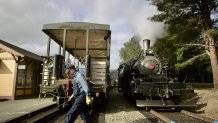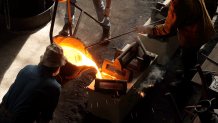In an unusual sort-of time-traveling-industrial-kinship, a historic Bay Area train steam engine in need of new parts is getting a helping hand from an equally historic gold country foundry. The history-inducing connection -- brake shoes.
The Niles Canyon Railroad’s historic steam engine — Clover Valley Lumber Steam Engine No. 4, which this month turned 100 — was in need of new brake shoes, an important feature for a hundred-ton behemoth.
“We wouldn’t be able to stop,” said Alan Siegwarth, a volunteer engineer with the railroad. “So we wouldn’t be able to run this locomotive without new brake shoes.”
As you might imagine, vintage steam engine parts aren’t the kind of thing you can just roll down and pick up at the local auto parts store. And these days, the kind of iron foundries that would’ve crafted such a part back in the day are exceedingly rare. Therein lies the rub.
“There’s very few places we could get them,” said Siegwarth.
Steam engine No. 4, the last survivor of California’s famous Baldwin logging locomotives, is an essential component of the historic volunteer-run Niles Canyon Railroad which was founded in the early 1980s — carrying visitors along a 12-mile loop of track through Sunol and Fremont. The railroad was intended to give riders the experience of train travel typical in the state during the early 1900s.

The railroad’s volunteers searched far and wide for a place that could make the parts, even attempting to craft the custom parts through a foundry in Canada, which didn’t work out.
Local
A potential solution came from a volunteer with the railroad who also volunteered at the historic Knight Foundry in Sutter Creek, California — not far from where gold was first discovered in 1848. He approached the leaders of the foundry to see if they could craft the parts from iron, using traditional industrial methods.
Get a weekly recap of the latest San Francisco Bay Area housing news. Sign up for NBC Bay Area’s Housing Deconstructed newsletter.
“He basically asked us if we’d be willing to work out a deal and build some parts for their locomotive that they’re working on,” said Wade Worsham, a volunteer with the foundry, which is celebrating its 150th anniversary. “Presto! We had some fun building some stuff for them.”
Inside old corrugated metal buildings, filled with original tools and metal-making contraptions, volunteers perform everything from black smithing demonstrations to pouring molten aluminum and iron. Huge belt-driven metal wheels whirred in every direction, which were originally operated by water. The foundry was started in 1873 to make high pressure water pumps for the mining industry.
The process for making the train’s brake shoes involved an old-time process of carving a wooden pattern, which is essentially a copy of the shape of the part, only made from wood.
A mold is then formed with the wood pattern using moist sand. In the most dramatic phase of the production, volunteers stoke a blazing fire and melt the iron, which is poured into the mold by a team of workers.
“We’re trying to preserve these traditional methods of making wood patterns,” said volunteer Joe Harralson who helped craft the brake shoe pattern, “trying to discover how did they do that 150 years ago.”

Harralson held up the pattern, which was painted bright red. The pattern shop also recently crafted parts for another historic railroad in the state. The foundry, which is open to the public a pair of Saturdays each month, mostly crafts aluminum objects for its gift shop. But the chance to pour iron, turned into an opportunity for both the railroad and the foundry.
“There aren’t that many people, need parts cast in iron,” said Jack Harrington, a volunteer with both the railroad and foundry who connected the two entities to build the brake shoes. “This gives us an outlet to be able to build our skill in iron casting.”
In another room of the foundry, a volunteer used a modern grinder to rough out the iron parts — about the only part of the process that incorporated modern tools.
“This is exactly how it would’ve been done 150 years ago,” said Worsham.
In an era of technology and artificial intelligence, it was the techniques of the past that ended-up saving the day for engine No. 4. For Siegwarth and the railroad, it was a case of a piece of history helping another.
“Preserving that knowledge and industries like Knight Foundry to be able to make the parts,” said Siegwarth, “is the whole key to success to what we’re doing.”



